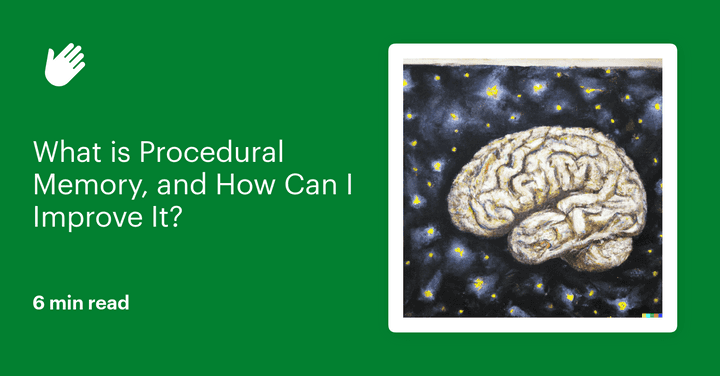What is Procedural Memory, and How Can I Improve It?

If you want to get a sense of how vital your procedural memory is, consider some of the things you’ve done so far today. You made your world-famous banana pancakes for breakfast. You rode your bike to the store. You typed on your laptop keys to answer two dozen emails. At lunch, you whiled away a few minutes playing “Classical Gas” on the guitar. In all of those instances, you were relying on your procedural memory.
Procedural memory is a component of long-term memory that deals with the performance of actions and skills. Being a form of implicit memory, it’s harder to directly train than explicit forms of memory. Nevertheless, with the right conditioning and lifestyle decisions, the performance of your procedural memory can be improved.
What is procedural memory?
Procedural memory is a repository of skills built up over long periods of time through repeated use and practice. A high-functioning procedural memory produces automatic responses to a range of simple or complex environmental stimuli by combining cognitive and motor responses. It’s why, to cite one example, you’re able to remember how to ride a bike without even having to try the second you place your hands on the handlebars.
Procedural memory is stored in the areas of the brain responsible for motor skills, like the prefrontal cortex or the cerebellum. It’s built up by procedural learning — several phases of activity through which new skills are absorbed into the brain as procedural knowledge.
- First is the cognitive phase, when a skill is observed and understood. Let’s say you’re learning to dance the tango. This would be the phase where you watch the dance being practiced by others, and you learn the steps.
- Next comes the associative phase, where you begin to practice tango steps until you start to feel yourself hitting each one without thinking about it. Your brain learns to differentiate between stimuli important to your ability to execute the skill (e.g., the music) and stimuli that are not (e.g., your instructor sneezing).
- Then comes the autonomous phase, where the skill can be performed without conscious awareness and even when you’re confronted with disruptive stimuli. By now, you can dance the tango even while your friend talks to you about their new HBO Max subscription.
The three primary phases of procedural learning are followed by additional practice (or ‘consolidation’), which helps retention of these autonomous “second nature” functions.
Procedural memory is implicit. People often confuse it with declarative memory. Declarative memory (which is divided into episodic memory and semantic memory) concerns the memory of facts and is a type of explicit memory, meaning that its contents must be called on by conscious effort. It’s also governed by different parts of the brain.
Procedural memory can be affected in different ways by a variety of medical conditions. For example, people who have Obsessive Compulsive Disorder (OCD) seem to demonstrate better-than-average procedural memory in the early stages of procedural learning due to overactivity in key areas of the brain. Similar results have been found for people with Tourette syndrome. On the other hand, procedural memory impairment can be caused by conditions like Parkinson’s disease and Alzheimer’s.
How we use procedural memory
We use our procedural memory for all the tasks in our daily life that seem second nature to us. It’s used to perform basic actions like writing, reading, tying a shoe, driving a car, and playing a musical instrument.
And procedural memory doesn’t just affect our capabilities in specialized tasks like this. People with highly developed procedural memory show a better ability to multi-task and divide their attention. You’ll have had experience with this if you’ve ever enjoyed an engrossing conversation while driving a car. Here, your procedural memory takes some of the strain of driving from your conscious mind, allowing you to drive safely while still continuing to chat.
How to improve your procedural memory
For better or for worse, there aren’t as many memory tasks effective for maximizing your procedural memory as there are for other parts of your memory. But you can still tailor your lifestyle and habits to get the most out of it.
The most direct and effective way to keep your procedural memory sharp is to consolidate your skills whenever you can. Practice is key, whether you’re trying to learn new procedural skills or you’re looking to improve your standards with existing ones. This is particularly important if the skill you’re practicing involves particularly complex cognitive or motor skills, like semi-professional sports or mental arithmetic.
Taking long naps also helps consolidate procedural memory. REM sleep is enormously important for new memory formation and for maintaining procedural memory quality. Studies have shown that taking naps longer than two hours after sequence learning helps consolidate procedural memory.
Procedural memory performance depends on healthy brain activity, so the quality of lifestyle you maintain will play a big role in keeping it functioning at a high level. Get high-quality sleep and do plenty of regular aerobic exercise. You should also aim to consume a diet rich in foods that correlate to improved brain function. These include fatty fish and other foods rich in omega-3s, turmeric, broccoli, dark chocolate, and nuts.
And avoid stress whenever possible to keep your procedural memory sharp. We all remember a heartbreaking moment when our favorite sportsperson missed a kick, a putt, a pass, or a shot when it counted most. That’s because high levels of anxiety can disrupt the procedural response of even the most skilled people. If you’re using your procedural memory in high-pressure situations — like competitions, live events, or even your job — stress management is key to keeping it running smoothly.
How you can expand your procedural memory
Procedural memory systems are there to help us deal with complex situations by quickly reminding us of what we know. And like the most miraculous of hotel concierges, the procedural memory does it all without us even having to ask.
But how great would it be if we could rely on our memory to remind us of facts and semantic information with the same autonomy that governs procedural memory? Well, here at Heyday, we’ve developed a tool that can help you get the same effect by surfacing useful information and content from your browsing history you might have forgotten about. Think of it as an external hard drive for all types of memory.
Try it today!
Ready for a memory boost?
Heyday automatically saves and resurfaces your content when you're Googling and reading online so you never forget things worth remembering.
